Silverstrike Project
Location, Access, Mineral Concessions & Ownership
The Silverstrike Project is located approximately 140 km southwest of La Paz, Bolivia, or about 450 km northwest of New Pacific’s Silver Sand Project. The property consists of 9 concessions (5 ATEs and 4 Exploration Licenses) covering a 44.5 km² area and sits at an elevation of 4,000-4,500 m. Access to the project is convenient, with 150 km of paved Highway 19 from La Paz and 30 km of gravel road to the project site.
In December 2019, the Company acquired a 98% interest in the Silverstrike Project from an arm’s length transaction with a private Bolivian corporation, making a one-time cash payment of US$1.35 million. Under the agreement, the Company’s Bolivian subsidiary is required to cover 100% of future expenditures, including exploration, development, and subsequent mining production costs at the Silverstrike Project. The agreement has a term of 30 years and is renewable for another 15 years.
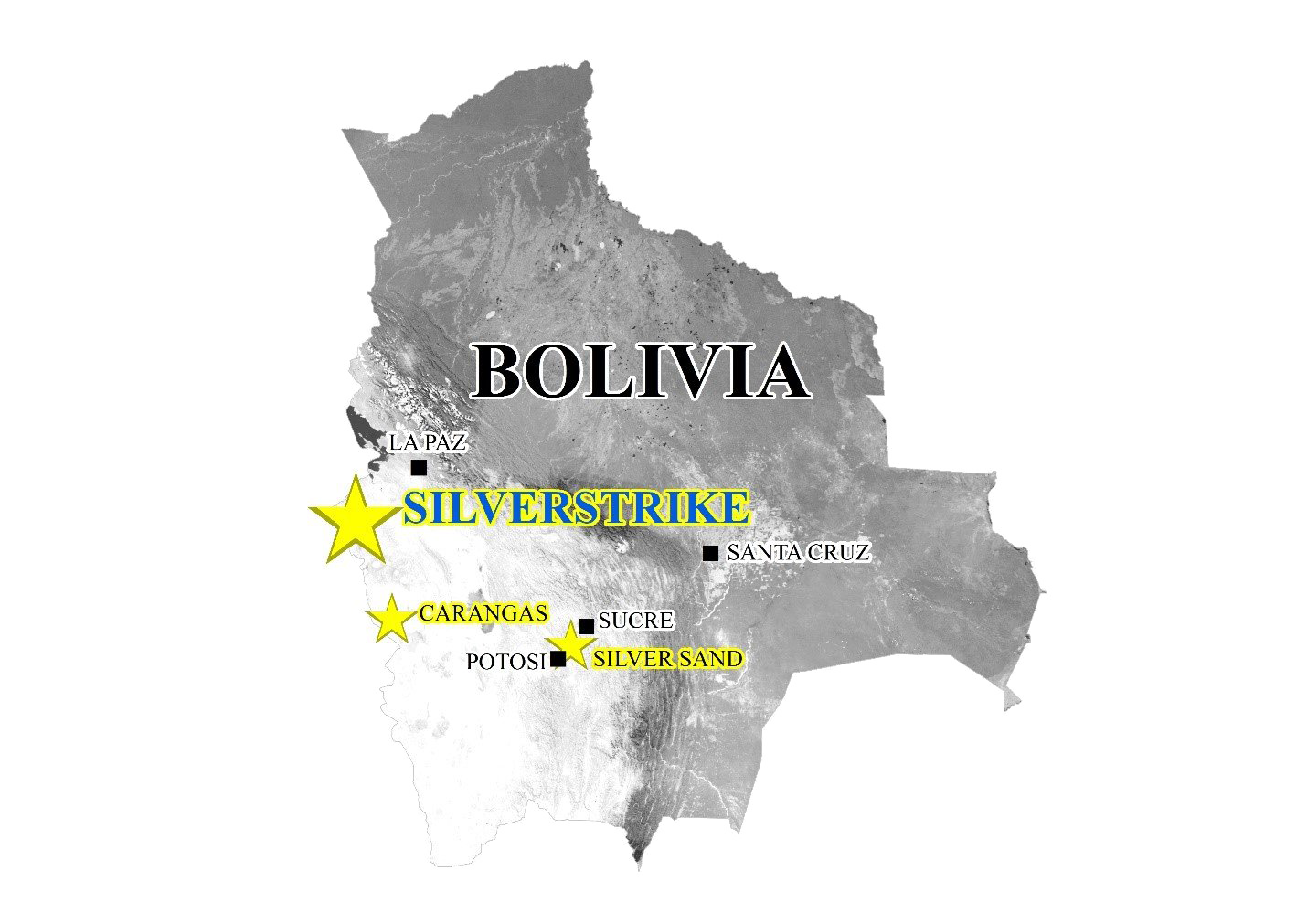
Geology and Mineralization
Geologically, Silverstrike consists of Tertiary red sandstone and mudstone sequences (Mauri and Beren Formations) extruded by a Tertiary rhyo-dacitic volcanic dome and associated pyroclastic sediments. The project shares many geological similarities to the Company’s Silver Sand and Carangas project, particularly in its sandstone-hosted structurally controlled silver-polymetallic mineralization and the presence of rhyolitic Tertiary intrusive rocks with corresponding multiple silver-rich occurrences associated with sericitic alteration. The property remains largely underexplored with limited modern exploration techniques applied.
In 2020, the Company completed reconnaissance and detailed mapping and sampling programs at three geologically distinct areas, namely Silverstrike North, Central and South, within which individual target zones have been identified.
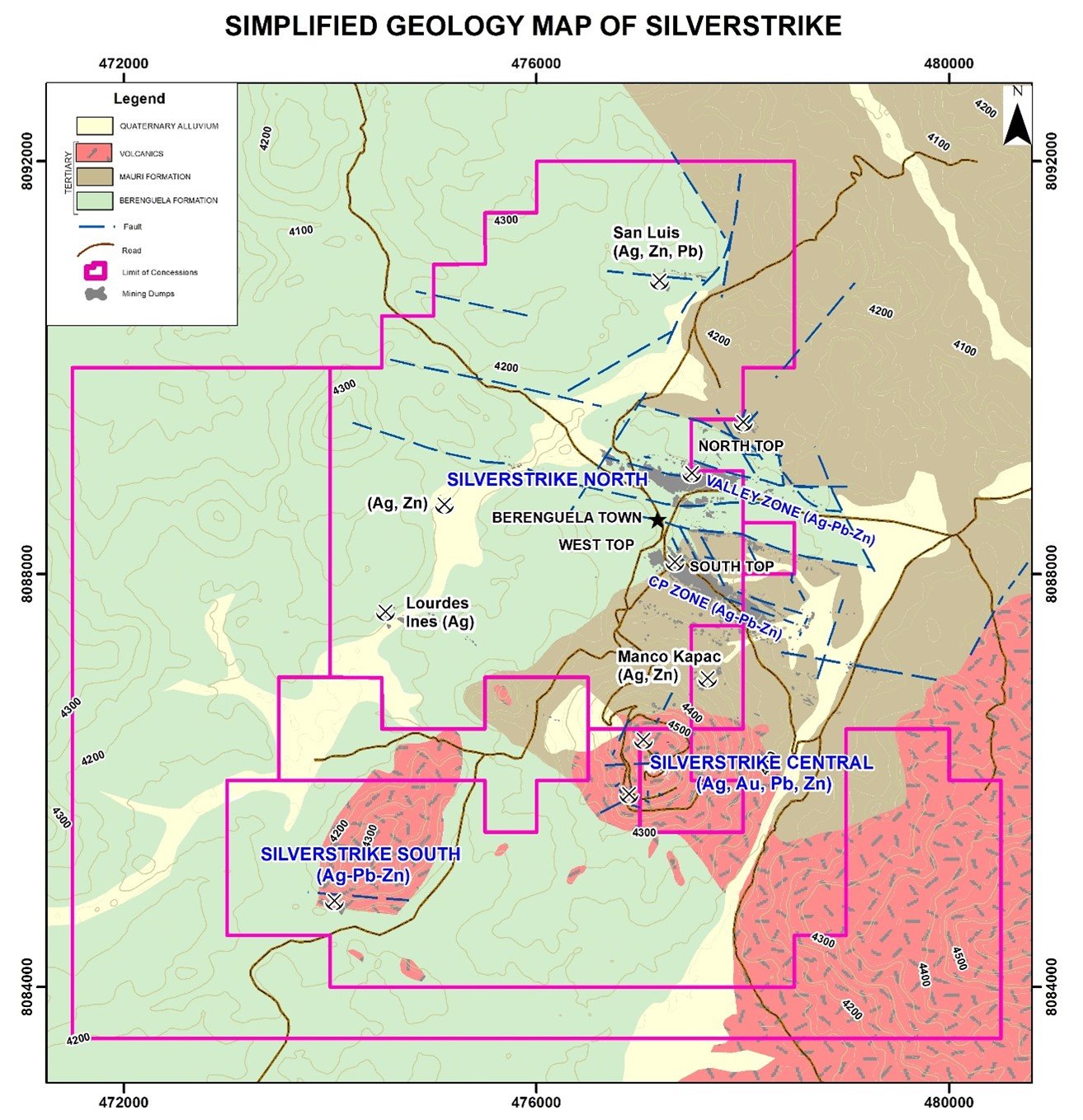
Silverstrike North
Silverstrike North is centred on the historic Berenguela Mining District and contains numerous historic mine adits, declines, shafts and mining dumps scattered intermittently over a 3.5 by 2.2 km area. It includes the Valley Zone, North Top, Tarafaya Mine, South Top, West Top, and CP Zone, in addition to the former San Luis Mine, Lourdes Ines Mine and the Turini Mine.
Silver-bearing sulfosalts and sulfides fill open fractures in bleached sandstones in the form of sheeted veins, swarm veinlets, stockworks, and crackle breccias. Dense fractures occur dominantly along the NWW to NW directions at high angles that are generally confined within the red sandstone, withstringers or feeder zones cutting through the underlying red mudstones.
Rio Tinto extensively sampled the mining dumps over a 1.5 km by 1.5 km area in 1995, yielding average grades of 150-200 g/t silver and 1% lead. Rio Tino also completed 1,000.6 m of diamond drilling in four holes at Silverstrike North. Hole PFZ001 intercepted 2 m @ 1,254 g/t Ag, 0.33% Pb, 0.19% Zn and 0.48% Cu from 88 m to 90 m. Hole PFZ002 intercepted 2 m @ 237 g/t Ag, 0.6% Pb, 0.07% Zn and 0.5% Cu from 120 m to 122 m. Two other holes drilled at the CP Zone did not intercept any meaningful mineralization.
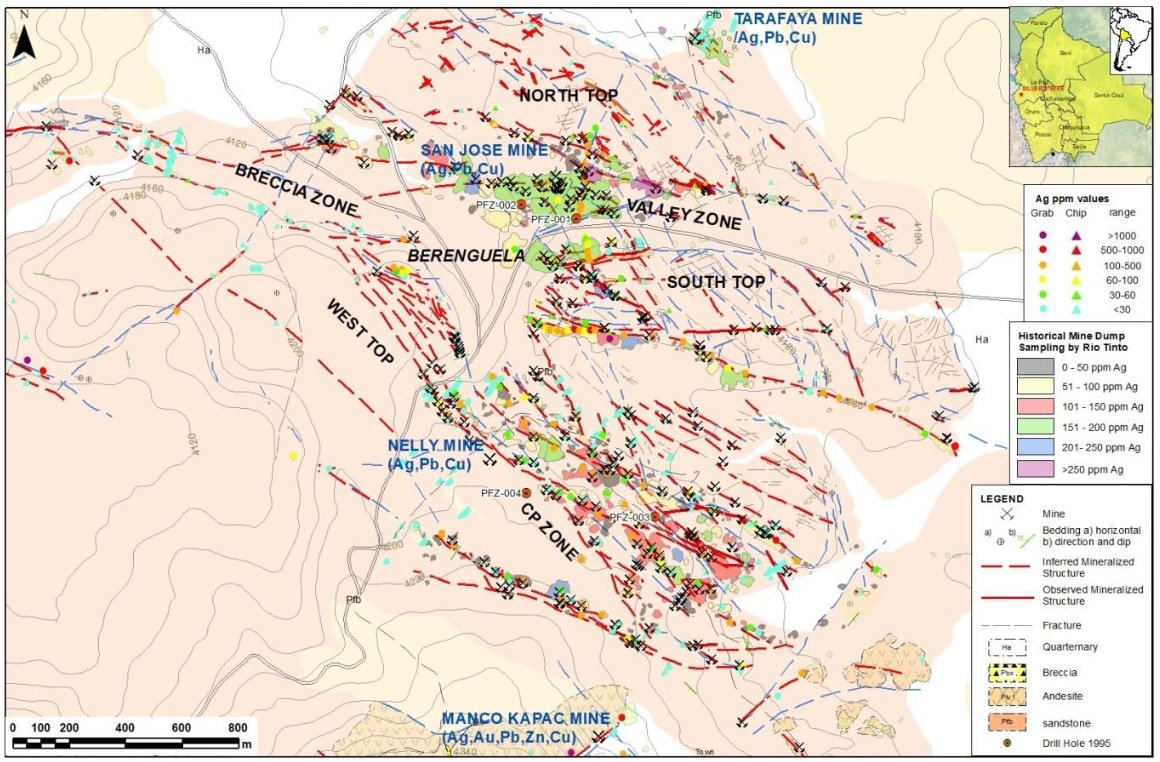
Exploration led by New Pacific in 2020 identified and sampled numerous mining adits, declines, shafts and surface open pits. Historic mining operations were developed along steeply dipping, 0.5-2 m wide fracture zones within altered and bleached Tertiary sandstones. In addition, several new mineralized zones were identified as part of the field work.
A total of 2,751 samples were collected, including 2,607 channel chip samples and 144 mine dump grab samples, of which 56 samples have silver grades >300 g/t (average 696 g/t Ag), 163 samples >100 g/t (average 347 g/t Ag), and 236 samples >50 g/t (average 262 g/t Ag). Most of the samples were taken from surface outcrops of alteration and mineralization, while the remaining samples were taken from historical underground workings.
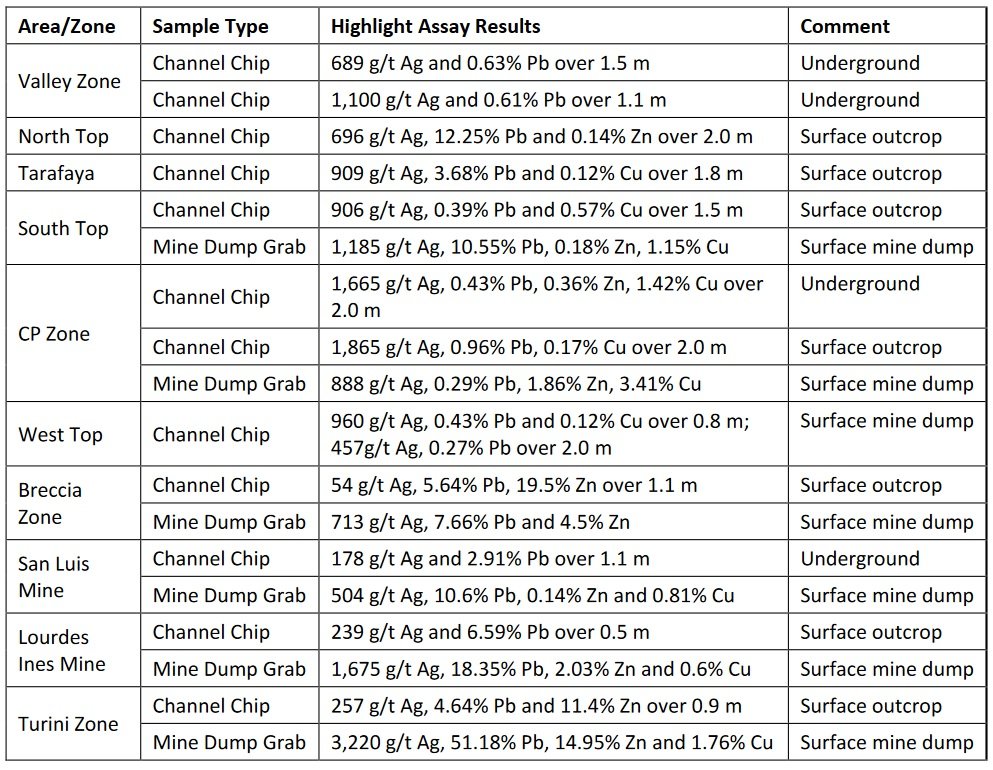

Silverstrike Central
Silverstrike Central is dominated by Cerro Tatitu Kkollu, a ~900 m diameter volcanic dome consisting of volcanoclastic sediments, breccias, rhyolite dyke swarms, and andesite flows. Three significant areas of structurally controlled mineralization are geologically associated with the volcanic complex: Manco Kapac, Tatitu Kkollu North, and Tatitu Kkollu South.
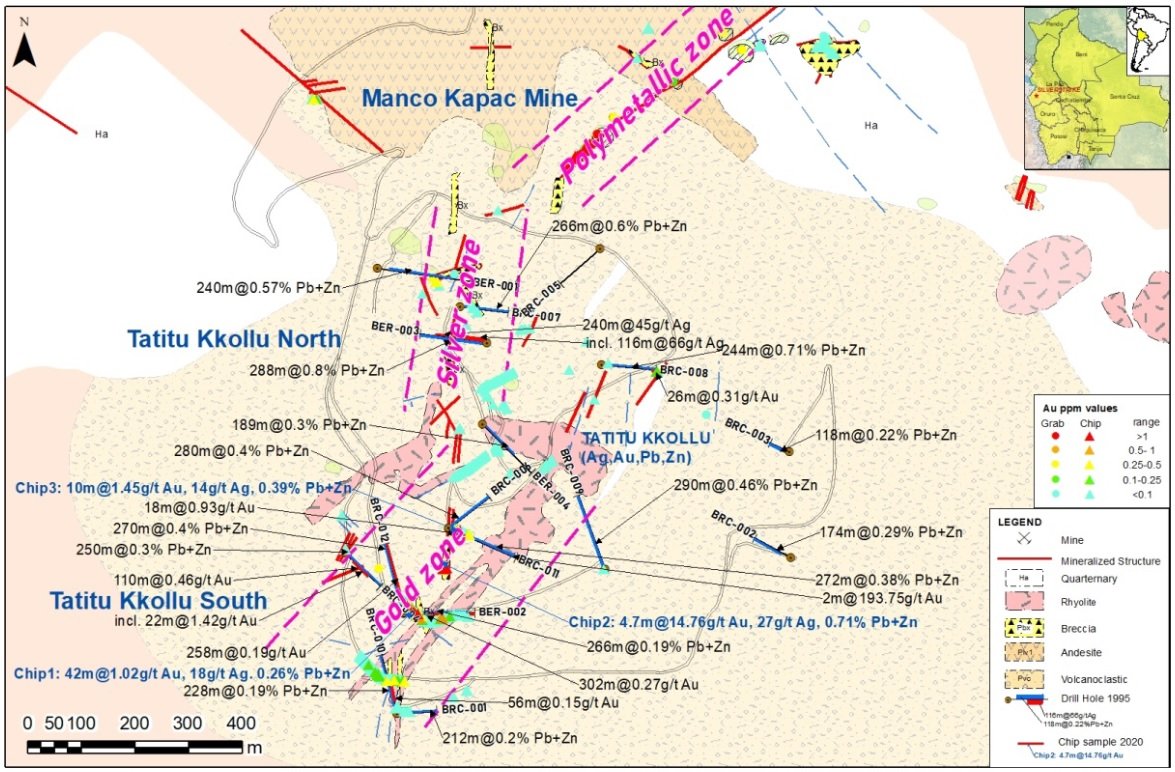
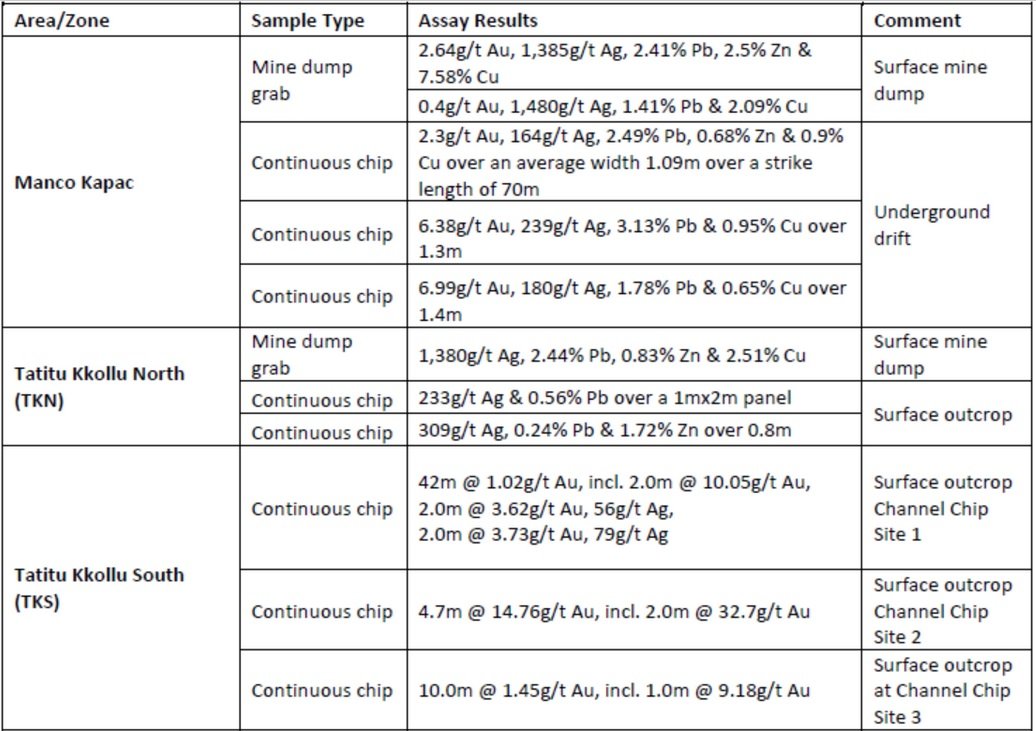
Approximately 700m north of the dome, the past producing Manco Kapac mine is characterized by mine dumps scattered along a NE trending, 700 m long by 200 m wide corridor. Mine dumps distribution suggests that multiple mineralized vein-breccia zones were exploited. However, most of the old underground workings are now inaccessible. Mineralization consists of silicified vein breccia cemented by disseminated gold and silver-rich polymetallic mineralization. Seven dump grab samples were collected, returning average grades of 0.58 g/t Au, 788 g/t Ag, 6.07% Pb, 5.48% Zn, and 2.79% Cu. In addition, 49 channel chip samples were taken, including 21 continuous chip samples from an accessible adit which returned an average grade of 2.3 g/t Au, 164 g/t Ag, 2.49% Pb, 0.68% Zn, and 0.9% Cu over an average width 1.09 m and strike length of 70 m.
Centred on and immediately to the north of the dome, Tatitu Kkollu North is a silver-rich zone associated with an NNE trending hydrothermal breccia measuring at least 50 m wide and 200 m long (estimated based on the surface expression of the limited outcrop in the area). A total of 61 samples (2 mine dumps and 59 channel chips) were collected. The two mine dump samples returned values of 1,380 g/t Ag, 2.44% Pb, 0.83% Zn and 2.51% Cu and 105 g/t Ag, 0.69% Pb and 13.25% Zn. Fifty-nine channel chip samples returned an average grade of 38 g/t Ag, 0.11% Pb and 0.23% Zn with the highest sample reporting 309 g/t Ag, 0.24% Pb and 1.72% Zn over 0.8m. The results are generally in line with historical drilling by Rio Tinto, which returned 220 m @ 45 g/t Ag, 0.51% Pb and 0.44% Zn from 13.0 m to 233.0 m in hole BER-3, including a higher-grade sub-interval of 116 m @ 66 g/t Ag, 0.81% Pb and 0.67% Zn from 13 m to 129 m downhole.
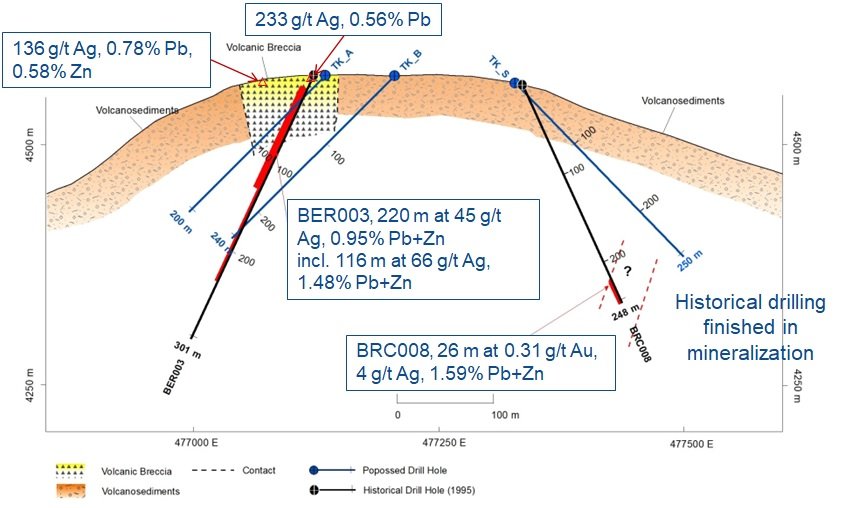
Gold-rich polymetallic mineralization at Tatitu Kkollu South occurs adjacent to the contact zones between volcanoclastic sediments and a NE trending rhyolite dyke swarm. A single dump grab sample collected from a historic exploration adit returned 1.66 g/t Au, 154 g/t Ag, 0.69% Pb, 0.3% Zn, and 7.97% Cu. A total of 277 channel chip samples were collected over three key outcropping areas–Channel Chip Sites 1 to 3. Channel Chip Site 2 returned the best results of 4.7m @ 14.76g/t Au, 27g/t Ag, 0.62% Pb and 0.46% Cu and remains open for expansion. Continuous mineralization of 42m @ 1.02 g/t Au, 18 g/t Ag, 0.15% Pb, and 0.11% Zn, including 2.0 m @ 10.05 g/t Au, 30 g/t Ag, 0.22% Pb, and 0.11% Zn was returned from Channel Chip Site-1. In addition, 10m @ 1.45 g/t, 14 g/t Ag, 0.36% Pb including 1.0 m @ 9.18 g/t Au, 42 g/t Ag and 0.74% Pb from Channel Chip Site-3. In addition to the composited intervals, isolated mineralized samples occur between lower-grade or barren intervals beyond the continuously mineralized intervals at Channel Chip Sites 1 and 3. Drilling by Rio Tinto in 1995 tested a small, near-surface portion of the target zone, returning broad intervals of Au mineralization:
BER-02 – 302 m @ 0.27 g/t Au within which 42 m returned 0.52 g/t Au.
BRC-04 – 110 m @ 0.46 g/t Au within which 22 m returned 1.42 g/t Au.
BRC-12 – 258 m @ 0.19 g/t Au.
Based on the Company’s field mapping, chipping sample, and limited historical drilling results, the Company interprets the gold zone as very similar to the gold discovery in the Carangas Project in that the silver rich zone sits at the top of the system, stacked on top of the gold mineralization in volcaniclastic sediments that intruded by rhyolitic porphyry dyke swarms.
Silverstrike South
At Silverstrike South, significant colonial-era mining dumps of the former Dos Amigos mine define an east-west trending, ~350 m long mineralized zone that is open on both ends and covered by surface talus. In addition, presently active hydrothermal sinter and associated sediments indicate that the structure has remained active over a geologically prolonged period. The Company interprets this as indicative of a metalliferous deep-seated structural zone.
Mineralization appears to be structurally controlled at the contact between a rhyolitic dome and Tertiary sediments. The width of the mineralized system is unknown, and the underground workings are inaccessible. Twenty-one channel chip samples were collected predominantly from the partially exposed hanging and footwall to the mined structure, returning average grades of 49 g/t Ag, with the highest up to 255 g/t Ag over 1.6 m.,
The scientific and technical information contained herein has been reviewed and approved by Alex Zhang, P. Geo., Vice President of Exploration, who is a Qualified Person for the purposes of National Instrument 43-101 — Standards of Disclosure for Mineral Projects (“NI 43-101”). The Qualified Person has verified the information disclosed herein using standard verification processes, including the sampling, preparation, security and analytical procedures underlying such information, and is not aware of any significant risks and uncertainties or any limitations on the verification process that could be expected to affect the reliability or confidence in the information discussed herein.
Please see the full text of New Pacific Metals Corp. news releases dated November 9, 2020, and September 29, 2020.
Exploration Highlights
New Pacific completed a 6,000 m discovery drill program at the Silverstrike Project in 2022. The program focused on testing previously identified broad gold and silver zones at Silverstrike Central, similar to the mineralization style of Carangas Project.At Silverstrike Central, results from the first two drill holes intersected broad oxidized gold mineralization near-surface.

Notes:
- Drill intercepts are core lengths, and grades are length weighted. True width of mineralization is unknown due to early stage of exploration without adequate drill data.
- Calculation of silver equivalent (“AgEq”) is based on the long-term median of the August 2022 Street Consensus Commodity Price Forecasts, which are US$22.50/oz for silver, US$0.95/lb for lead, US$1.10/lb for zinc, and US$3.40/lb for copper.
- A cut-off of 20g/t AgEq is applied for the calculation of length-weighted intercepts.

Gold mineralization is hosted in volcanic clastic sediments (breccia or ignimbrites) and controlled by fractures that extend approximately to the North-East fractures and dip at high angles. High-grade gold intervals are shown to occur near the contacts of ignimbrites and rhyolitic dykes. The host rocks appear oxidized with brownish-reddish iron oxides and hydroxides filling in fractures.

The scientific and technical information contained herein has been reviewed and approved by Alex Zhang, P. Geo., Vice President of Exploration, who is a Qualified Person for the purposes of National Instrument 43-101 — Standards of Disclosure for Mineral Projects (“NI 43-101”). The Qualified Person has verified the information disclosed herein using standard verification processes, including the sampling, preparation, security and analytical procedures underlying such information, and is not aware of any significant risks and uncertainties or any limitations on the verification process that could be expected to affect the reliability or confidence in the information discussed herein.
Please see the full text of New Pacific Metals Corp. news releases dated November 1, 2022, and September 12, 2022.
